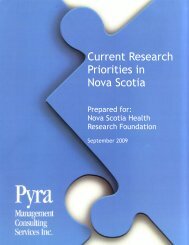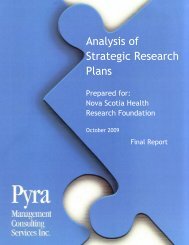Major Health Issues in Nova Scotia: An Environmental Scan
Major Health Issues in Nova Scotia: An Environmental Scan
Major Health Issues in Nova Scotia: An Environmental Scan
Create successful ePaper yourself
Turn your PDF publications into a flip-book with our unique Google optimized e-Paper software.
# Reference Brief Notes<br />
to implement the Code of Practice more rigorously, but while it<br />
rema<strong>in</strong>s voluntary it is unlikely to solve the problem, <strong>in</strong> view of the<br />
(relative) shortage of healthcare professionals <strong>in</strong> this country. Other<br />
measures, <strong>in</strong>clud<strong>in</strong>g promot<strong>in</strong>g the retention of locally tra<strong>in</strong>ed staff <strong>in</strong><br />
the U.K., are urgently required.<br />
Options for Expand<strong>in</strong>g Cont<strong>in</strong>u<strong>in</strong>g Care: <strong>An</strong>notated Inventory of Reviews<br />
# Reference Brief Notes<br />
1. Forbes,DA and Neufeld,A. Loom<strong>in</strong>g n/a<br />
dementia care crisis: Canada needs an<br />
<strong>in</strong>tegrated model of cont<strong>in</strong>u<strong>in</strong>g care now!<br />
Can.J.Nurs.Res.; 2008; 40(1):9-16.<br />
2. Kodner,DL. Whole-system approaches to<br />
health and social care partnerships for the<br />
frail elderly: <strong>An</strong> exploration of North<br />
American models and lessons.<br />
<strong>Health</strong>.Soc.Care.Community; 2006; 14(5):384-<br />
90.<br />
Irrespective of cross-national differences <strong>in</strong> long-term care, countries<br />
confront broadly similar challenges, <strong>in</strong>clud<strong>in</strong>g fragmented services,<br />
disjo<strong>in</strong>ted care, less-than-optimal quality, system <strong>in</strong>efficiencies and<br />
difficult-to-control costs. Integrated or whole-system strategies are<br />
becom<strong>in</strong>g <strong>in</strong>creas<strong>in</strong>gly important to address these shortcom<strong>in</strong>gs<br />
through the seamless provision of health and social care. This article<br />
summarises the structure, features and outcomes of the Program of<br />
All-Inclusive Care for Elderly People (PACE) programme <strong>in</strong> the<br />
United States, and the Systeme de so<strong>in</strong>s Integres pour Personnes<br />
Agees (SIPA) and the Programme of Research to Integrate Services<br />
for the Ma<strong>in</strong>tenance of Autonomy (PRISMA) <strong>in</strong> Canada. It concludes<br />
with the identification of common characteristics which are thought<br />
to be associated with the successful impact of these partnership<br />
<strong>in</strong>itiatives, as well as a call for further research to understand the<br />
relationships, if any, between whole-system models, services and<br />
3. McKay,JR. Cont<strong>in</strong>u<strong>in</strong>g care research: What<br />
we have learned and where we are go<strong>in</strong>g.<br />
J.Subst.Abuse Treat.; 2009; 36(2):131-45.<br />
4. McKay,JR. Cont<strong>in</strong>u<strong>in</strong>g care <strong>in</strong> the treatment<br />
of addictive disorders. Curr.Psychiatry Rep.;<br />
2006; 8(5):355-62.<br />
5. Oldman,C. Deceiv<strong>in</strong>g, theoriz<strong>in</strong>g and selfjustification:<br />
A critique of <strong>in</strong>dependent<br />
liv<strong>in</strong>g. Crit.Soc.Policy); 2003; 23(1):44,62.<br />
outcomes <strong>in</strong> <strong>in</strong>tegrated care for elderly people.<br />
In the field of addiction treatment, the term cont<strong>in</strong>u<strong>in</strong>g care has been<br />
used to <strong>in</strong>dicate the stage of treatment that follows an <strong>in</strong>itial episode<br />
of more <strong>in</strong>tensive care. This article reviews controlled studies of<br />
cont<strong>in</strong>u<strong>in</strong>g care conducted over the prior 20 years. The results<br />
<strong>in</strong>dicate that cont<strong>in</strong>u<strong>in</strong>g care <strong>in</strong>terventions were more likely to<br />
produce positive treatment effects when they had a longer planned<br />
duration, made more active efforts to deliver treatment to patients,<br />
and were studied more recently. The use of alternative service<br />
delivery methods and care sett<strong>in</strong>gs may also lead to greater<br />
engagement and retention <strong>in</strong> cont<strong>in</strong>u<strong>in</strong>g care, particularly among the<br />
large numbers of <strong>in</strong>dividuals who do not want traditional, cl<strong>in</strong>ic-based<br />
specialty care.<br />
Newer models of cont<strong>in</strong>u<strong>in</strong>g care <strong>in</strong> the addictions are designed to<br />
improve the long-term management of substance use disorders by<br />
engag<strong>in</strong>g patients <strong>in</strong>to flexible, or "adaptive," treatment algorithms<br />
that change <strong>in</strong> focus and <strong>in</strong>tensity as symptoms wax and wane over<br />
time. This article describes some of these newer approaches to the<br />
management of substance use disorders and presents recent research<br />
on their effectiveness.<br />
The article starts with an exam<strong>in</strong>ation of some key paradigms of later<br />
life and then employs their <strong>in</strong>sights to expose the powerful and<br />
deceptive discourse of '<strong>in</strong>dependent liv<strong>in</strong>g', which has recently been<br />
one of social policy's most persuasive mantras. The theoretical<br />
perspective that <strong>in</strong>forms the whole article is that of postmodernism<br />
with a critical gerontology perspective. The critique of <strong>in</strong>dependent











